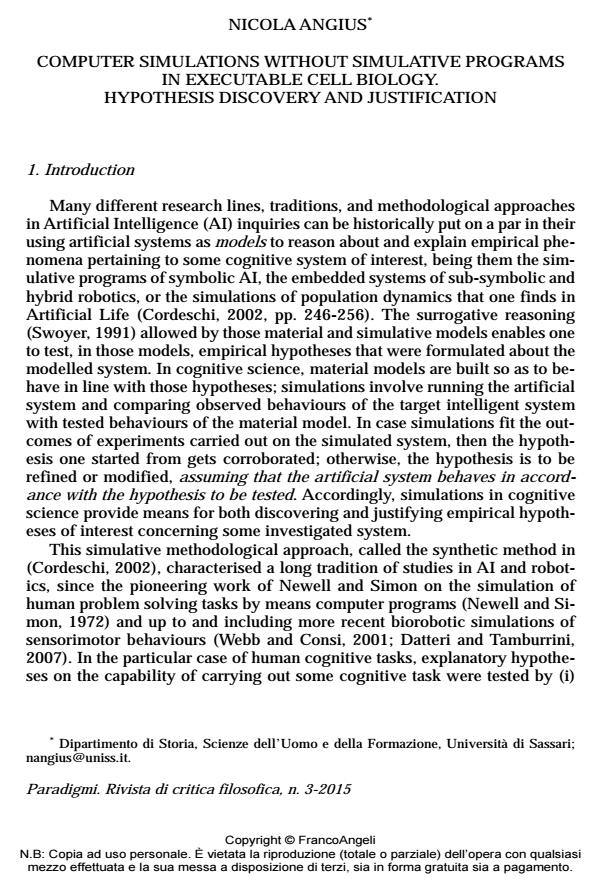Computer simulations without simulative programs in executable cell biology. Hypothesis discovery and justification
Titolo Rivista PARADIGMI
Autori/Curatori Nicola Angius
Anno di pubblicazione 2016 Fascicolo 2015/3 Lingua Inglese
Numero pagine 16 P. 67-82 Dimensione file 118 KB
DOI 10.3280/PARA2015-003005
Il DOI è il codice a barre della proprietà intellettuale: per saperne di più
clicca qui
Qui sotto puoi vedere in anteprima la prima pagina di questo articolo.
Se questo articolo ti interessa, lo puoi acquistare (e scaricare in formato pdf) seguendo le facili indicazioni per acquistare il download credit. Acquista Download Credits per scaricare questo Articolo in formato PDF

FrancoAngeli è membro della Publishers International Linking Association, Inc (PILA)associazione indipendente e non profit per facilitare (attraverso i servizi tecnologici implementati da CrossRef.org) l’accesso degli studiosi ai contenuti digitali nelle pubblicazioni professionali e scientifiche
L’applicazione dei metodi formali per l’analisi di programmi reattivi che simulano i comportamenti di sistemi cellulari in biologia computazionale è presa in esame per gettare nuova luce sugli approcci simulativi in Intelligenza Artificiale e Vita Artificiale. In primo luogo, si sottolinea come i programmi che simulano i comportamenti di molti sistemi reattivi cellulari sono più proficuamente esaminati per mezzo di modelli eseguibili delle esecuzioni del programma simulativo. Tali modelli risultano essere rappresentazioni sia del programma simulativo che del sistema cellulare simulato. In secondo luogo, si evidenzia come i processi di scoperta di comportamenti di interesse del sistema simulato vengano effettuati attraverso verifiche algoritmiche condotte sul modello formale che rappresenta i fenomeni biologici di studio. Infine, un tratto metodologico distintivo dell’attuale biologia computazionale viene riconosciuto nel fatto che le ipotesi avanzate sulla base di modelli eseguibili non sono confermate o falsificate testando il programma simulativo, il quale non viene nemmeno codificato, ma effettuando esperimenti in vitro finalizzati ad osservare i comportamenti del sistema naturale corrispondenti ai percorsi del modello che soddisfano o violano le ipotesi in corso di valutazione
Keywords:Biologia eseguibile, Filosofia dell’informatica, Metodi simulativi, Model-Based reasoning, Model checking, Vita artificiale.
- Ammann P. and Offutt J. (2008). Introduction to software testing. Cambridge: Cambridge University Press.
- Angius N. (2013). Model-based abductive reasoning in automated software testing. Logic Journal of IGPL, 21, 6: 931-942.
- Angius N. (2014). The problem of justification of empirical hypotheses in software testing. Philosophy & Technology, 27, 3: 423-439.
- Baier C. and Katoen J.P. (2008). Principles of model checking. Cambridge (MA): MIT Press.
- Bernardo M., de Vink E., Di Pierro A., and Wiklicky H., eds. (2013). Formal methods for dynamical systems. 13th International School on Formal Methods for the Design of Computer, Communication, and Software Systems, Lecture Notes in Computer Science, 7938. Berlin: Springer. DOI: 10.1007/978-3-642-38874-3
- Brim L., Češka M. and Šafránek D. (2013). Model checking of biological systems. Formal Methods for Dynamical Systems, Berlin-Heidelberg: Springer.
- Callahan J., Schneider F. and Easterbrook S. (1996). Automated software testing using model-checking. Proceedings SPIN workshop, 353: 118-127.
- Clarke E. M., Grumberg O. and Peled D. (1999). Model checking. Cambridge (MA): MIT Press.
- Cordeschi R. (2002). The discovery of the artificial: behavior, mind and machines before and beyond cybernetics. Dordrecht: Kluwer. DOI: 10.1007/978-94-015-9870-5
- Datteri E. and Tamburrini G. (2007). Biorobotic experiments for the discovery of biological mechanisms. Philosophy of Science, 74, 3: 409-430.
- Dijkstra E.W. (1970). Notes on structured programming. Technical Report 70-WSK-03, Department of Mathematics, The Netherlands: Technical University Einhdoven.
- Fisher J. and Henzinger T.A. (2007). Executable cell biology. Nature Biotechnology, 25, 11: 1239-1249.
- Fisher J., Harel D. and Henzinger T.A. (2011). Biology as reactivity. Communications of the ACM, 54, 10: 72-82.
- Kitano H. (2002). Computational systems biology. Nature, 420, 6912: 206-210.
- Klipp E., Liebermeister W., Wierling C., Kowald A., Lehrach H. and Herwig, R. (2013). Systems biology. Weinheim: John Wiley & Sons.
- Kröger F. and Merz S. (2008). Temporal logic and state systems. Berlin: Springer Science & Business Media.
- Magnani, L. (2004). Model-based and manipulative abduction in science. Foundations of Science, 9, 3: 219-247.
- Magnani, L. Nersessian, N. and Thagard P. (1999). Model-based reasoning in scientific discovery. Dordrecht: Kluwer.
- Monin J.F. (2012). Understanding formal methods. Berlin: Springer Science & Business Media.
- Newell A. and Simon H.A. (1972). Human problem solving. Englewood Cliffs (NJ): Prentice-Hall.
- Rosenblueth A. and Wiener N. (1945). The role of models in science. Philosophy of Science, 12, 4: 316-321.
- Rosenblueth A., Wiener N. and Bigelow, J. (1943). Behavior, purpose and teleology. Philosophy of Science, 10, 1: 18-24.
- Schaub M.A., Henzinger T.A. and Fisher J. (2007). Qualitative networks: A symbolic approach to analyze biological signaling networks. BMC Systems Biology, 1, 1: 4.
- Shapiro S. (1997). Splitting the difference: the historical necessity of synthesis in software engineering. Annals of the History of Computing, IEEE International Conferences, 19, 1: 20-54.
- Swoyer C. (1991). Structural representation and surrogative reasoning. Synthese, 87, 3: 449-508.
- Tamburrini G. and Datteri E. (2005). Machine experiments and theoretical modelling: from cybernetic methodology to neuro-robotics. Minds and Machines, 15, 3-4: 335-358.
- Turner R. (2013). The philosophy of computer science. The Stanford Encyclopedia of Philosophy. Stanford: Stanford University.
- Van Leeuwen J. (1990). Handbook of theoretical computer science. Volume B: formal models and semantics. Cambridge (MA): MIT Press.
- Vardi M.Y. and Wolper P. (1986), An automata-theoretic approach to automatic program verification (preliminary report), 1st Annual Symposium on Logic in Computer Science (LICS), IEEE: 332-344.
- Explaining Engineered Computing Systems’ Behaviour: the Role of Abstraction and Idealization Nicola Angius, Guglielmo Tamburrini, in Philosophy & Technology /2017 pp.239
DOI: 10.1007/s13347-016-0235-1
Nicola Angius, Computer simulations without simulative programs in executable cell biology. Hypothesis discovery and justification in "PARADIGMI" 3/2015, pp 67-82, DOI: 10.3280/PARA2015-003005